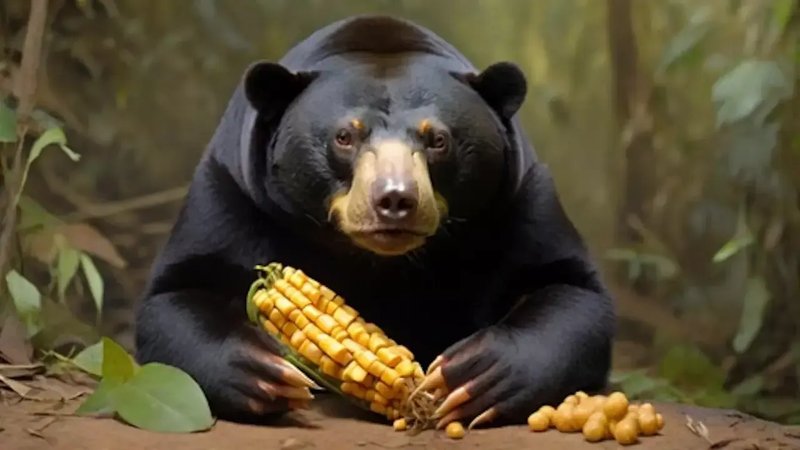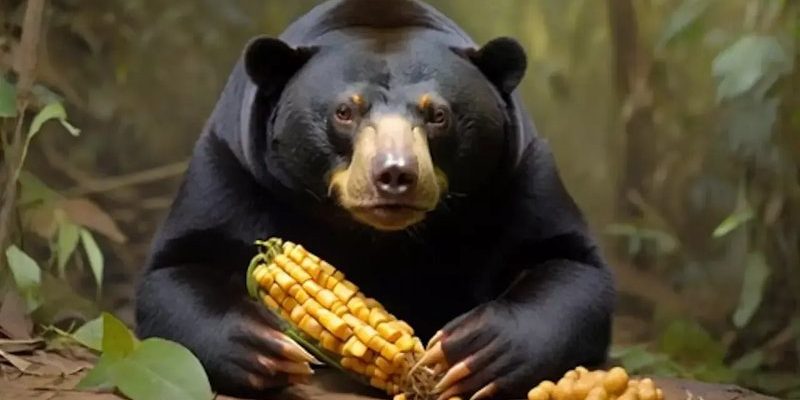
Sun bears are a bit like the ninjas of the bear family. They’re stealthy, agile, and have some pretty impressive skills when it comes to finding food. Unlike their larger relatives, sun bears have adapted to a fruit-rich, insect-heavy environment where they often rely on their keen sense of smell and strong climbing abilities. Let’s explore how these creatures hunt and what exactly makes up their diet—it’s more interesting than you might think!
Understanding the Sun Bear’s Habitat
Sun bears are native to the tropical forests of Southeast Asia, including countries like Malaysia, Thailand, and Indonesia. Their homes are dense and lush, filled with fruit trees, honey, and plenty of insects. Imagine walking through a warm, humid forest where the sounds of chirping birds and buzzing insects surround you. That’s where you’d find these bears.
They often prefer areas with tall trees, which give them a place to climb and search for food. Sun bears are incredibly strong climbers, thanks to their long claws and powerful limbs. This unique adaptation allows them to reach high branches where delicious treats like fruit and honey are waiting. However, they’re not just limited to trees; they also scavenge the forest floor for insects and small animals, showcasing their diverse foraging skills.
The Sun Bear’s Diet: A Fruity Affair
When it comes to diet, sun bears have quite the palate. They’re omnivorous, meaning they eat both plants and animals. But what does that really look like? Let me break it down for you:
- Fruits: Sun bears love fruits like durians, mangosteens, and bananas. Their sweet-tooth tendencies lead them to forage for ripe fruits in the canopy.
- Insects: These bears are also big fans of insects, especially ants and termites. They use their long, sticky tongues to scoop up these tasty snacks, almost like a bear version of using chopsticks!
- Honey: You might find them climbing trees, searching for bee hives. Their love for honey is legendary, and they’ll often take significant risks to enjoy this sweet treat.
In addition to these favorites, sun bears will also eat small mammals, birds, and sometimes even plant roots. This variety in their diet is crucial for their survival, especially in an ecosystem where food availability can change seasonally.
Foraging and Hunting Techniques
Now that we know what sun bears eat, let’s look at how they find their food. Their hunting strategies are quite unique and involve using specialized skills that have developed over time.
First off, scent detection plays a massive role. Sun bears have an incredible sense of smell—much stronger than that of humans. This allows them to locate hidden food sources buried deep in the forest. When they catch a whiff of ripe fruit or a beehive, they’re quick to follow that scent trail.
Another fascinating aspect is their climbing ability. Sun bears can easily ascend trees to reach fruits or honey. You’ll often see them hanging from branches, using their powerful limbs and sharp claws to navigate the heights. Their climbing skills give them access to food that many other animals can’t reach.
Lastly, sun bears are masters of breaking open logs or tree trunks. They do this to access insects nesting inside. It’s like they’re using tools, showcasing their intelligent approach to foraging. This ability not only sustains them but helps maintain the ecosystem by aerating the soil and creating habitats for other wildlife.
The Role of Social Behavior in Hunting
You might think of sun bears as solitary creatures. While they do spend much of their time alone, social behavior does play a role in their hunting strategies. For instance, a mother bear will teach her cubs where to find food and how to hunt effectively.
Cubs learn by watching their mothers. They’ll tag along while she forages, picking up skills along the way. This learning process is vital for their survival, especially in a world full of potential dangers. Young bears who learn these tricks early are much more likely to thrive once they leave their mother’s side.
Additionally, sun bears are known to share their findings with one another in certain situations. This communal behavior can lead to more successful foraging, especially when food is scarce. You might see them together at a fruiting tree or competing for a honeycomb, showcasing a fascinating blend of independence and cooperation.
The Importance of Conservation
Unfortunately, sun bears are classified as vulnerable due to habitat loss and poaching. Deforestation, primarily caused by logging and agricultural practices, is a significant threat to their habitat. It’s like taking away the ingredients from a beloved recipe—without those natural spaces, sun bears struggle to find enough food.
Conservation efforts are crucial to help protect sun bears and their ecosystems. Organizations are working hard to raise awareness, implement habitat restoration, and establish wildlife reserves. It’s a team effort that requires support from all of us—because sun bears are not just fascinating animals; they also play an essential role in maintaining the health of their environment.
Final Thoughts on Sun Bears and Their Survival
In summary, the diet and hunting strategies of the sun bear reveal how resourceful and adaptable these small bears are. From their impressive climbing abilities to their keen sense of smell, they’ve developed unique methods to thrive in their lush Southeast Asian habitats.
Understanding their behavior not only deepens our appreciation for these remarkable creatures but also emphasizes the importance of conservation efforts. Sun bears are more than just a cute face; they’re vital players in their ecosystems. If we want to keep witnessing their awe-inspiring hunting skills and delicious fruit feasts, it’s time to step up our efforts to protect their homes.

